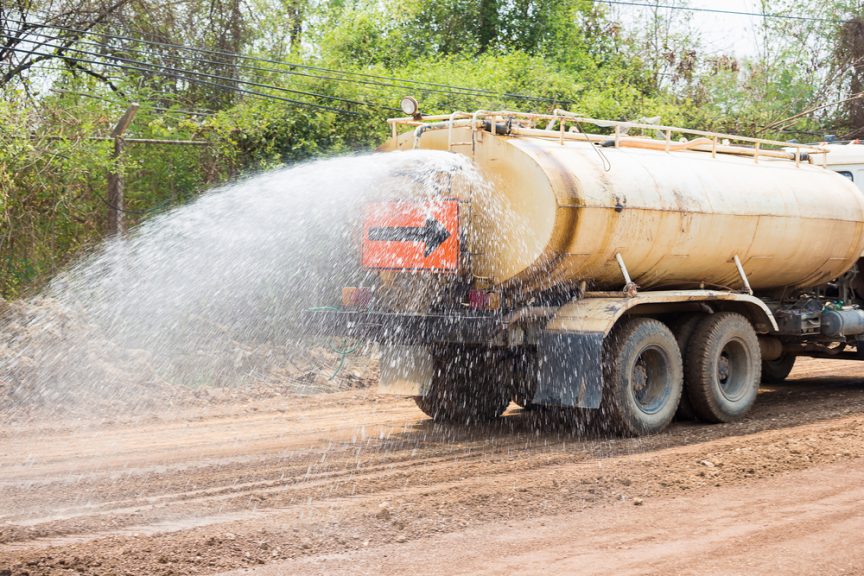The cost of dust control can be intimidating — until you realize how much you’re already spending on inefficient dust control practices and programs.
The cost of dust control cannot be determined without first considering the cost of not performing dust control. Fugitive dust can cause thousands of dollars of damage to industrial equipment — plus, if a significant amount of dust particulate escapes from on-site roads, bumpy driving conditions can lead to employee injuries and even worker’s comp claims. Furthermore, failure to comply with air quality regulations can lead to serious administrative headaches and hefty fines.
With all of these factors in mind, it should be obvious that failure to keep dust under control comes at a significant cost. When you do decide to invest, however, it’s crucial that you understand how to determine your dust control needs, how an effective dust control program is structured, and most importantly, how to measure the cost of dust control.
The True Cost of Cracking Down on Dust
One form of dust control that will always fail to achieve sufficient results is watering, the simple method of spraying down unpaved roads with water trucks to keep dust from escaping the surface. It’s easy to see why this method would be appealing: it’s incredibly easy, affordable, and it usually appears as if dust has been altogether suppressed immediately after treatment.
The long-term consequences of watering, however, have costs that far outweigh the initial savings. Watering degrades roads over time by washing away and eliminating the fines that hold them together. The result, more often than not, is potholes and rutting, both of which can damage vehicles and usually necessitate the use of graders to repair them. Operators become trapped in a negative cycle between watering roads, then grading and partially rebuilding them to offset the effect of watering. This negative cycle of watering often results in expenditures that well exceed budget expectations.
Other dust control programs use far more efficient and less damaging dust control solutions than water, but are applied ineffectively. 60% of a dust control program’s success lies in its proper application, and if the applicator fails to recognize factors that could influence the efficiency of the solution (such as those covered below), the entire program could end up being a waste of precious budget. A good program thoroughly audits the worksite and develops a plan for tackling the specific needs and conditions of area, using different products and approaches for different roads and yards if necessary to ensure results.
What Variables Influence the Cost of Dust Control?
Countless numbers of variables ultimately affect the final price tag attached to dust control, but let’s highlight a few of the most crucial:
Predetermined Needs & Objectives: Again, the cost of a dust control program will always depend on its objectives. The rise in cost between 85% control efficiency and 95% control efficiency can be exponential — that’s why it’s so important to determine the exact dust control needs of your site before you commit to a program.
Site-Specific Circumstances & Conditions: The desired level of dust control efficiency at any given site will depend on additional factors like climate, traffic volume, and the location of air monitors, to name a few. Precipitation, site-specific traffic routes, and environmental regulations will all affect the overall cost of dust control too, as you may need to apply different product chemistries at different rates to accommodate varying site conditions.
Method of Application: Dust control products need to be sprayed with equipment made to support high-viscosity fluids; if you don’t have that equipment on-site, Midwest offers an outsourced Managed Service Program or can help you purchase the right equipment and implement training for an insourced program. Proper application is more than half the battle for a successful dust control program, so you’ll want to make sure it’s done right.
Midwest Does Dust Control the Right Way
At Midwest Industrial Supply, Inc., we understand that when you pay for dust control, you expect significant benefits for your site and lasting results. At Midwest, it’s not about selling product — it’s about getting the job done, no matter what happens along the way.
Our 40 years of experience suppressing dust has enabled us to develop and implement solutions to the complex problems facing industrial facilities and municipalities. In doing so, we draw upon a diverse suite of dust control products: for instance, our synthetic organic fluid with the EK35® binder captures fines and keep them locked into the road surface, preventing PM10 and PM2.5 emissions from escaping.
So regardless of your site’s specific needs, Midwest is there to help.


